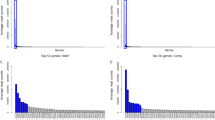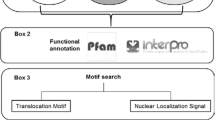Abstract
Trichoderma afroharzianum is one of the best characterized Trichoderma species, and strains have been utilized as plant disease suppressive inoculants. In contrast, Trichoderma gamsii has only recently been described, and there is limited knowledge of its disease suppressive efficacies. Comparative studies of changes in gene expression during interactions of these species with their target plant pathogens will provide fundamental information on pathogen antibiosis functions. In the present study, we used complementary DNA amplified fragment length polymorphism (cDNA-AFLP) analysis to investigate changes in transcript profiling of T. afroharzianum strain LTR-2 and T. gamsii strain Tk7a during in vitro interactions with plant pathogenic Rhizoctonia solani and Pythium irregulare. Considerable differences were resolved in the overall expression profiles of strains LTR-2 and Tk7a when challenged with either plant pathogen. In strain LTR-2, previously reported mycoparasitism-related genes such as chitinase, polyketide synthase, and non-ribosomal peptide synthetase were found to be differentially expressed. This was not so for strain Tk7a, with the only previously reported antibiosis-associated genes being small secreted cysteine-rich proteins. Although only one differentially expressed gene was common to both strains LTR-2 and Tk7a, numerous genes reportedly associated with pathogen antibiosis processes were differentially expressed in both strains, including degradative enzymes and membrane transport proteins. A number of novel potential antibiosis-related transcripts were found from strains LTR-2 and Tk7a and remain to be identified. The expression kinetics of 20 Trichoderma (10 from strain LTR-2, 10 from strain Tk7a) transcript-derived fragments (TDFs) were quantified by quantitative reverse transcription PCR (RT-qPCR) at pre- and post-mycelia contact stages of Trichoderma-prey interactions, thereby confirming differential gene expression. Collectively, this research is providing information to elucidate the antibiosis mechanisms and disease suppressive activities of T. afroharzianum and T. gamsii against soilborne fungal and oomycete plant pathogens.



Similar content being viewed by others
References
Anees M, Tronsmo A, Edel-Hermann V, Hjeljord LG, Heraud C, Steinberg C (2010) Characterization of field isolates of Trichoderma antagonistic against Rhizoctonia solani. Fungal Biol 114:691–701. doi:10.1016/j.funbio.2010.05.007
Atanasova L, Le Crom S, Gruber S, Coulpier F, Seidl-Seiboth V, Kubicek CP, Druzhinina IS (2013) Comparative transcriptomics reveals different strategies of Trichoderma mycoparasitism. BMC Genomics 14:121. doi:10.1186/1471-2164-14-121
Chaverri P, Branco-Rocha F, Jaklitsch WM, Gazis RO, Degenkolb T, Samuels GJ (2015) Systematics of the Trichoderma harzianum species complex and the reidentification of commercial biocontrol strains. Mycologia. doi:10.3852/14-147
Cook RJ (2001) Management of wheat and barley root diseases in modern farming systems. Australas Plant Pathol 30:119–126
Cox RJ (2007) Polyketides, proteins and genes in fungi: programmed nano-machines begin to reveal their secrets. Org Biomol Chem 5:2010–2026. doi:10.1039/b704420h
Druzhinina IS, Kopchinskiy AG, Komon M, Bissett J, Szakacs G, Kubicek CP (2005) An oligonucleotide barcode for species identification in Trichoderma and Hypocrea. Fungal Genet Biol 42:813–828
Druzhinina IS, Kubicek CP, Komon-Zelazowska M, Mulaw TB, Bissett J (2010) The Trichoderma harzianum demon: complex speciation history resulting in coexistence of hypothetical biological species, recent agamospecies and numerous relict lineages. BMC Evol Biol 10:94. doi:10.1186/1471-2148-10-94
Druzhinina IS, Seidl-Seiboth V, Herrera-Estrella A, Horwitz BA, Kenerley CM, Monte E, Mukherjee PK, Zeilinger S, Grigoriev IV, Kubicek CP (2011) Trichoderma: the genomics of opportunistic success. Nat Rev Microbiol 9:749–759. doi:10.1038/nrmicro2637
Duffy BK, Simon A, Weller DM (1996) Combination of Trichoderma koningii with fluorescent pseudomonads for control of take-all on wheat. Phytopathology 86:188–194
Grigoriev IV, Nordberg H, Shabalov I et al (2012) The genome portal of the department of energy joint genome institute. Nucleic Acids Res 40:D26–32. doi:10.1093/nar/gkr947
Harvey PR, Butterworth PJ, Hawke BH, Pankhurst CE (2000) Genetic variation among populations of Pythium irregulare in southern Australia. Plant Pathol 49:619–627
Harvey PR, Stummer BE, Warren RA, Zhang Q, Zhang X, Li J, Yang H (2014) Trichoderma gamsii and T. harzianum suppress Pythium-Rhizoctonia root disease complexes in southern Australian cropping systems. in: proceedings of 13th international workshop on Trichoderma and Gliocladium. Shanghai, China, p 32
Jaklitsch WM, Samuels GJ, Dodd SL, Lu BS, Druzhinina IS (2006) Hypocrea rufa/Trichoderma viride: a reassessment, and description of five closely related species with and without warted conidia. Stud Mycol 56:135–177. doi:10.3114/sim.2006.56.04
Kawabe M, Okabe Onokubo A, Arimoto Y, Yoshida T, Azegami K, Teraoka T, Arie T (2011) GMC oxidoreductase, a highly expressed protein in a potent biocontrol agent Fusarium oxysporum Cong:1–2, is dispensable for biocontrol activity. J Gen Appl Microbiol 57:207–217
Kubicek CP, Baker S, Gamauf C, Kenerley CM, Druzhinina IS (2008) Purifying selection and birth-and-death evolution in the class II hydrophobin gene families of the ascomycete Trichoderma/Hypocrea. BMC Evol Biol 8:4. doi:10.1186/1471-2148-8-4
Kubicek CP et al (2011) Comparative genome sequence analysis underscores mycoparasitism as the ancestral life style of Trichoderma. Genome Biol 12:R40. doi:10.1186/gb-2011-12-4-r40
Leiter E, Marx F, Pusztahelyi T, Haas H, Pocsi I (2004) Penicillium chrysogenum glucose oxidase -- a study on its antifungal effects. J Appl Microbiol 97:1201–1209. doi:10.1111/j.1365-2672.2004.02423.x
Livak KJ, Schmittgen TD (2001) Analysis of relative gene expression data using real-time quantitative PCR and the 2-ΔΔCt method. Methods 25(4):402–408
Lu Z, Tombolini R, Woo S, Zeilinger S, Lorito M, Jansson JK (2004) In vivo study of trichoderma-pathogen-plant interactions, using constitutive and inducible green fluorescent protein reporter systems. Appl Environ Microbiol 70:3073–3081
Matarese F, Sarrocco S, Gruber S, Seidl-Seiboth V, Vannacci G (2012) Biocontrol of Fusarium head blight: interactions between Trichoderma and mycotoxigenic Fusarium. Microbiology 158:98–106. doi:10.1099/mic.0.052639-0
Mukherjee PK, Horwitz BA, Kenerley CM (2012) Secondary metabolism in Trichoderma – a genomic perspective. Microbiology 158:35–45. doi:10.1099/mic.0.053629-0
Murray GM, Brennan JP (2010) Estimating disease losses to the Australian barley industry. Australas Plant Pathol 39:85–96
Ogoshi A (1996) The genus Rhizoctonia. In: Sneh B, Jabaji-Hare S, Neate S, Dijst G (eds) Rhizoctonia species, taxonomy, molecular biology, ecology pathology and disease control. Kluwer Academic Publishers, Dordrecht, pp 1–9
Petrovic T, Burgess LW, Cowie I, Warren RA, Harvey PR (2013) Diversity and fertility of Fusarium sacchari from wild rice (Oryza australiensis) in Northern Australia, and pathogenicity tests with wild rice, rice, sorghum and maize. Eur J Plant Pathol 136:773–788
Reithner B, Ibarra-Laclette E, Mach RL, Herrera-Estrella A (2011) Identification of mycoparasitism-related genes in Trichoderma atroviride. Appl Environ Microbiol 77:4361–4370. doi:10.1128/AEM.00129-11
Rinu K, Sati P, Pandey A (2014) Trichoderma gamsii (NFCCI 2177): a newly isolated endophytic, psychrotolerant, plant growth promoting, and antagonistic fungal strain. J Basic Microbiol 54:408–417. doi:10.1002/jobm.201200579
Rovira AD, Ogoshi A, McDonald HJ (1986) Characterisation of isolates of Rhizoctonia solani from cereal roots in South Australia and New South Wales. Phytopathology 76:1245–1248
Ryder MH, Warren RA, Harvey PR, Tang W, Yang H, Zhang X, Zhang BX (2005) Recent advances in biological control of soil-borne root diseases of wheat, vegetables and cotton in China and Australia. Shandong Sci 18:1–8
Samolski I, de Luis A, Vizcaíno J, Monte E, Suárez M (2009) Gene expression analysis of the biocontrol fungus Trichoderma harzianum in the presence of tomato plants, chitin, or glucose using a high-density oligonucleotide microarray. BMC Microbiol 9:217. doi:10.1186/1471-2180-9-217
Scherm B, Schmoll M, Balmas V, Kubicek C, Migheli Q (2009) Identification of potential marker genes for Trichoderma harzianum strains with high antagonistic potential against Rhizoctonia solani by a rapid subtraction hybridization approach. Curr Genet 55:81–91. doi:10.1007/s00294-008-0226-6
Simon A, Sivasithamparam K (1988) Microbiological differences between soils suppressive and conducive of the saprophytic growth of Gaeurnannomyces graminis var. tritici. Can J Microbiol 34:860–864
Steindorff AS, Ramada MH, Coelho AS, Miller RN, Pappas GJ Jr, Ulhoa CJ, Noronha EF (2014) Identification of mycoparasitism-related genes against the phytopathogen Sclerotinia sclerotiorum through transcriptome and expression profile analysis in Trichoderma harzianum. BMC Genomics 15:204. doi:10.1186/1471-2164-15-204
Stosz SK, Fravel DR, Roberts DP (1996) In vitro analysis of the role of glucose oxidase from Talaromyces flavus in biocontrol of the plant pathogen Verticillium dahliae. Appl Environ Microbiol 62:3183–3186
Struck AW, Thompson ML, Wong LS, Micklefield J (2012) S-adenosyl-methionine-dependent methyltransferases: highly versatile enzymes in biocatalysis, biosynthesis and other biotechnological applications. Chembiochem Euro J Chem Biol 13:2642–2655. doi:10.1002/cbic.201200556
Tang W, Gao J, Yang H, Luo D, Yan Z, Mei R, Ryder MH, Rovira AD (1996) Seed treatment by microorganisms for control of takeall and sharp eyespot of wheat in field trials in China. In: Tang W, Cook RJ, Rovira A (eds) Advances in biological control of plant diseases. China Agricultural University Press, Beijing, pp 38–43
Van der Plaats-Niterink AJ (1981) Monograph of the genus Pythium. Stud Mycol 21:1–242
Varese GC et al (2011) Ex situ conservation and exploitation of fungi in Italy. Plant Biosystems Int J Deal Asp Plant Biol 145:997–1005. doi:10.1080/11263504.2011.633119
Vieira PM, Coelho AS, Steindorff AS, de Siqueira SJ, Silva Rdo N, Ulhoa CJ (2013) Identification of differentially expressed genes from Trichoderma harzianum during growth on cell wall of Fusarium solani as a tool for biotechnological application. BMC Genomics 14:177. doi:10.1186/1471-2164-14-177
Vuylsteke M, Peleman JD, van Eijk MJ (2007) AFLP-based transcript profiling (cDNA-AFLP) for genome-wide expression analysis. Nat Protoc 2:1399–1413. doi:10.1038/nprot.2007.174
Yao L, Yang Q, Song J, Tan C, Guo C, Wang L, Qu L, Wang Y (2013) Cloning, annotation and expression analysis of mycoparasitism-related genes in Trichoderma harzianum 88. J Microbiol 51:174–182. doi:10.1007/s12275-013-2545-7
Acknowledgments
This work was supported by Dr. Paul Harvey’s Taishan Research Fellowship (Shandong Province, PR China), the National Natural Science Foundation of China (31101479), the Australian Grains Research and Development Corporation (CSA00031), and the S&T Development Program of Shandong Government (2013GNC11019, 2014GSF121028). Dr. Xinjian Zhang was also supported by an Australian Endeavour Research Fellowship for part of this work.
Author information
Authors and Affiliations
Corresponding authors
Electronic supplementary material
Below is the link to the electronic supplementary material.
ESM 1
(DOCX 30 kb)
Rights and permissions
About this article
Cite this article
Zhang, X., Harvey, P.R., Stummer, B.E. et al. Antibiosis functions during interactions of Trichoderma afroharzianum and Trichoderma gamsii with plant pathogenic Rhizoctonia and Pythium . Funct Integr Genomics 15, 599–610 (2015). https://doi.org/10.1007/s10142-015-0456-x
Received:
Revised:
Accepted:
Published:
Issue Date:
DOI: https://doi.org/10.1007/s10142-015-0456-x




